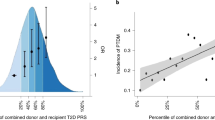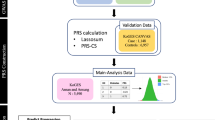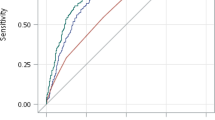Abstract
New Onset Diabetes after Transplantation (NODAT) is a frequent complication after solid organ transplantation, with higher incidence during the first year. Several clinical and genetic factors have been described as risk factors of Type 2 Diabetes (T2DM). Additionally, T2DM shares some genetic factors with NODAT. We investigated if three genetic risk scores (w-GRS) and clinical factors were associated with NODAT and how they predicted NODAT development 1 year after transplantation. In both main (n = 725) and replication (n = 156) samples the clinical risk score was significantly associated with NODAT (ORmain: 1.60 [1.36–1.90], p = 3.72*10−8 and ORreplication: 2.14 [1.39–3.41], p = 0.0008, respectively). Two w-GRS were significantly associated with NODAT in the main sample (ORw-GRS 2:1.09 [1.04–1.15], p = 0.001 and ORw-GRS 3:1.14 [1.01–1.29], p = 0.03) and a similar ORw-GRS 2 was found in the replication sample, although it did not reach significance probably due to a power issue. Despite the low OR of w-GRS on NODAT compared to clinical covariates, when integrating w-GRS 2 and w-GRS 3 in the clinical model, the Area under the Receiver Operating Characteristics curve (AUROC), specificity, sensitivity and accuracy were 0.69, 0.71, 0.58 and 0.68, respectively, with significant Likelihood Ratio test discrimination index (p-value 0.0004), performing better in NODAT discrimination than the clinical model alone. Twenty-five patients needed to be genotyped in order to detect one misclassified case that would have developed NODAT 1 year after transplantation if using only clinical covariates. To our knowledge, this is the first study extensively examining genetic risk scores contributing to NODAT development.
This is a preview of subscription content, access via your institution
Access options
Subscribe to this journal
Receive 6 print issues and online access
$259.00 per year
only $43.17 per issue
Buy this article
- Purchase on Springer Link
- Instant access to full article PDF
Prices may be subject to local taxes which are calculated during checkout

Similar content being viewed by others
References
Pham PT, Pham PC, Lipshutz GS, Wilkinson AH. New onset diabetes mellitus after solid organ transplantation. Endocrinol Metab Clin North Am 2007;36:873–90. vii
Gomes MB, Cobas RA. Post-transplant diabetes mellitus. Diabetol Metab Syndr 2009;1:14.
Kasiske BL, Snyder JJ, Gilbertson D, Matas AJ. Diabetes mellitus after kidney transplantation in the United States. Am J Transplant 2003;3:178–85.
Fernandez-Fresnedo G, Escallada R, de Francisco AL, Rodrigo E, Zubimendi JA, Ruiz JC, et al. Posttransplant diabetes is a cardiovascular risk factor in renal transplant patients. Transplant Proc 2003;35:700.
Cosio FG, Kudva Y, van der Velde M, Larson TS, Textor SC, Griffin MD, et al. New onset hyperglycemia and diabetes are associated with increased cardiovascular risk after kidney transplantation. Kidney Int 2005;67:2415–21.
Reisaeter AV, Hartmann A. Risk factors and incidence of posttransplant diabetes mellitus. Transplant Proc 2001;33(5A Suppl):8s–18s.
Sumrani NB, Delaney V, Ding ZK, Davis R, Daskalakis P, Friedman EA, et al. Diabetes mellitus after renal transplantation in the cyclosporine era--an analysis of risk factors. Transplantation 1991;51:343–7.
Arner P, Gunnarsson R, Blomdahl S, Groth CG. Some characteristics of steroid diabetes: a study in renal-transplant recipients receiving high-dose corticosteroid therapy. Diabetes Care 1983;6:23–25.
Knoll GA, Bell RC. Tacrolimus versus cyclosporin for immunosuppression in renal transplantation: meta-analysis of randomised trials. BMJ 1999;318:1104–7.
Johnston O, Rose CL, Webster AC, Gill JS. Sirolimus is associated with new-onset diabetes in kidney transplant recipients. J Am Soc Nephrol 2008;19:1411–8.
Kurzawski M, Dziewanowski K, Lapczuk J, Wajda A, Drozdzik M. Analysis of common type 2 diabetes mellitus genetic risk factors in new-onset diabetes after transplantation in kidney transplant patients medicated with tacrolimus. Eur J Clin Pharmacol 2012;68:1587–94.
Voight BF, Scott LJ, Steinthorsdottir V, Morris AP, Dina C, Welch RP, et al. Twelve type 2 diabetes susceptibility loci identified through large-scale association analysis. Nat Genet 2010;42:579–89.
Song M, Zhao F, Ran L, Dolikun M, Wu L, Ge S, et al. The Uyghur population and genetic susceptibility to type 2 diabetes: potential role for variants in CDKAL1, JAZF1, and IGF1 genes. OMICS 2015;19:230–7.
Hivert MF, Jablonski KA, Perreault L, Saxena R, McAteer JB, Franks PW, et al. Updated genetic score based on 34 confirmed type 2 diabetes Loci is associated with diabetes incidence and regression to normoglycemia in the diabetes prevention program. Diabetes 2011;60:1340–8.
Mahajan A, Go MJ, Zhang W, Below JE, Gaulton KJ, Ferreira T, et al. Genome-wide trans-ancestry meta-analysis provides insight into the genetic architecture of type 2 diabetes susceptibility. Nat Genet 2014;46:234–44.
McCaughan JA, McKnight AJ, Maxwell AP. Genetics of new-onset diabetes after transplantation. J Am Soc Nephrol 2014;25:1037–49.
Quteineh L, Bochud PY, Golshayan D, Crettol S, Venetz JP, Manuel O, et al. CRTC2 polymorphism as a riks factor for the incidence of metabolic syndrome traits in patients with solid organ transplantation. Pharmacogenomics J 2017;17:69–75.
Koller MT, van Delden C, Muller NJ, Baumann P, Lovis C, Marti HP, et al. Design and methodology of the Swiss Transplant Cohort Study (STCS): a comprehensive prospective nationwide long-term follow-up cohort. Eur J Epidemiol 2013;28:347–55.
Crettol S, Venetz JP, Fontana M, Aubert JD, Ansermot N, Fathi M, et al. Influence of ABCB1 genetic polymorphism on cyclosporine intracellular concentrations in transplant recipients. Pharmacogenet Genomics 2008;18:307–15.
Crettol S, Venetz JP, Fontana M, Aubert JD, Pascual M, Eap CB. CYP3A7, CYP3A5, CYP3A4, and ABCB1 genetic polymorphisms, cyclosporine concentration, and dose requirement in transplant recipients. Ther Drug Monit 2008;30:689–99.
Pham PT, Pham PM, Pham SV, Pham PA, Pham PC. New onset diabetes after transplantation (NODAT): an overview. Diabetes Metab Syndr Obes 2011;4:175–86.
Speliotes EK, Willer CJ, Berndt SI, Monda KL, Thorleifsson G, Jackson AU, et al. Association analyses of 249,796 individuals reveal 18 new loci associated with body mass index. Nat Genet 2010;42:937–48.
Janssens AC, Moonesinghe R, Yang Q, Steyerberg EW, van Duijn CM, Khoury MJ. The impact of genotype frequencies on the clinical validity of genomic profiling for predicting common chronic diseases. Genet Med 2007;9:528–35.
Robin X, Turck N, Hainard A, Tiberti N, Lisacek F, Sanchez JC, et al. pROC: an open-source package for R and S + to analyze and compare ROC curves. BMC Bioinformatics 2011;12:77.
Pencina MJ, D’Agostino RB Sr., D’Agostino RB Jr., Vasan RS. Evaluating the added predictive ability of a new marker: from area under the ROC curve to reclassification and beyond. Stat Med 2008;27:157–72. discussion 207-112
Pencina MJ, D’Agostino RB, Pencina KM, Janssens AC, Greenland P. Interpreting incremental value of markers added to risk prediction models. Am J Epidemiol 2012;176:473–81.
Borobia AM, Lubomirov R, Ramirez E, Lorenzo A, Campos A, Muñoz-Romo R, et al. An acenocoumarol dosing algorithm using clinical and pharmacogenetic data in Spanish patients with thromboembolic disease. PLoS ONE 2012;7:e41360.
Hui H, Dotta F, Di Mario U, Perfetti R. Role of caspases in the regulation of apoptotic pancreatic islet beta-cells death. J Cell Physiol 2004;200:177–200.
Maedler K, Spinas GA, Lehmann R, Sergeev P, Weber M, Fontana A, et al. Glucose induces beta-cell apoptosis via upregulation of the Fas receptor in human islets. Diabetes 2001;50:1683–90.
Rathi M, Rajkumar V, Rao N, Sharma A, Kumar S, Ramachandran R, et al. Conversion from tacrolimus to cyclosporine in patients with new-onset diabetes after renal transplant: an open-label randomized prospective pilot study. Transplant Proc 2015;47:1158–61.
Kerr KF, McClelland RL, Brown ER, Lumley T. Evaluating the incremental value of new biomarkers with integrated discrimination improvement. Am J Epidemiol 2011;174:364–74.
Pepe MS, Janes HE. Gauging the performance of SNPs, biomarkers, and clinical factors for predicting risk of breast cancer. J Natl Cancer Inst 2008;100:978–9.
Montori VM, Basu A, Erwin PJ, Velosa JA, Gabriel SE, Kudva YC. Posttransplantation diabetes: a systematic review of the literature. Diabetes Care 2002;25:583–92.
Chakkera HA, Weil EJ, Swanson CM, Dueck AC, Heilman RL, Reddy KS, et al. Pretransplant risk score for new-onset diabetes after kidney transplantation. Diabetes Care 2011;34:2141–5.
Swiss Transplant Cohort Study
The members of the Swiss Transplant Cohort Study are: Rita Achermann, Patrizia Amico, John-David Aubert, Vanessa Banz, Guido Beldi, Christian Benden, Christoph Berger, Isabelle Binet, Pierre-Yves Bochud, Heiner Bucher, Leo Bühler, Thierry Carell, Emmanuelle Catana, Yves Chalandon, Sabina de Geest, Olivier de Rougemont, Michael Dickenmann, Michel Duchosal, Laure Elkrief, Thomas Fehr, Sylvie Ferrari-Lacraz, Christian Garzoni, Paola Gasche Soccal, Christophe Gaudet, Emiliano Giostra, Déla Golshayan, Karine Hadaya, Jörg Halter, Dominik Heim, Christoph Hess, Sven Hillinger, Hans H. Hirsch, Günther Hofbauer, Uyen Huynh-Do, Franz Immer, Richard Klaghofer, Michael Koller (Head of the data center), Bettina Laesser, Roger Lehmann, Christian Lovis, Oriol Manuel, Hans-Peter Marti, Pierre Yves Martin, Pascal Meylan, (Head, Biological samples management group), Paul Mohacsi, Philippe Morel, Ulrike Mueller, Nicolas J Mueller (Chairman Scientific Committee), Helen Mueller-McKenna (Head of local data management), Antonia Müller, Thomas Müller, Beat Müllhaupt, David Nadal, Manuel Pascual (Executive office), Jakob Passweg, Juliane Rick, Eddy Roosnek, Anne Rosselet, Silvia Rothlin, Frank Ruschitzka, Urs Schanz, Stefan Schaub, Aurelia Schnyder, Christian Seiler, Susanne Stampf, Jürg Steiger (Head, Executive Office), Guido Stirnimann, Christian Toso, Christian Van Delden (Executive office), Jean-Pierre Venetz, Jean Villard, Madeleine Wick (STCS coordinator), Markus Wilhelm, Patrick Yerly.
Funding
This work has been funded in part by the Swiss National Science Foundation (CBE: 324730_144064 and 320030_173211). LQ and CBE received research support from the Roche Organ Transplantation Research Foundation (#152358701) and the Swiss Transplant Cohort Study in the past 3 years. ZK was funded by the Swiss National Science Foundation (31003A-143914) and the Leenaards Foundation. This study has been conducted in the framework of the Swiss Transplant Cohort Study, supported by the Swiss National Science Foundation and the Swiss University Hospitals (G15) and transplant centers.
Author information
Authors and Affiliations
Consortia
Corresponding author
Ethics declarations
Conflict of interest
C.B.E. received honoraria for conferences or teaching CME courses from Astra Zeneca, Janssen-Cilag, Lundbeck, Merck Sharp & Dohme, Mepha, Otsuka, Servier and Vifor-Pharma in the past 3 years. He received an unrestricted educational grant from Takeda in the past 3 years. J.F.D. Advisory committees: Bayer, BMS, Gilead Science, Janssen Cilag, Jennerex, Merck, Novartis, Roche. Speaking and teaching: Bayer, Boehringer-Ingelheim, Novartis, Roche. SC received honoraria for teaching CME courses from Astra Zeneca and Lundbeck. The remaining authors declare that they have no competing interests.
Electronic supplementary material
Rights and permissions
About this article
Cite this article
Saigi-Morgui, N., Quteineh, L., Bochud, PY. et al. Genetic and clinic predictors of new onset diabetes mellitus after transplantation. Pharmacogenomics J 19, 53–64 (2019). https://doi.org/10.1038/s41397-017-0001-5
Received:
Revised:
Accepted:
Published:
Issue Date:
DOI: https://doi.org/10.1038/s41397-017-0001-5
This article is cited by
-
Donor and recipient polygenic risk scores influence the risk of post-transplant diabetes
Nature Medicine (2022)
-
Clinical and genetic risk factors for new-onset diabetes mellitus after transplantation (NODAT) in major transplant centres in Malaysia
BMC Nephrology (2020)
-
Post-transplant diabetes mellitus: incidence, predicting factors and outcomes
Endocrine (2020)



